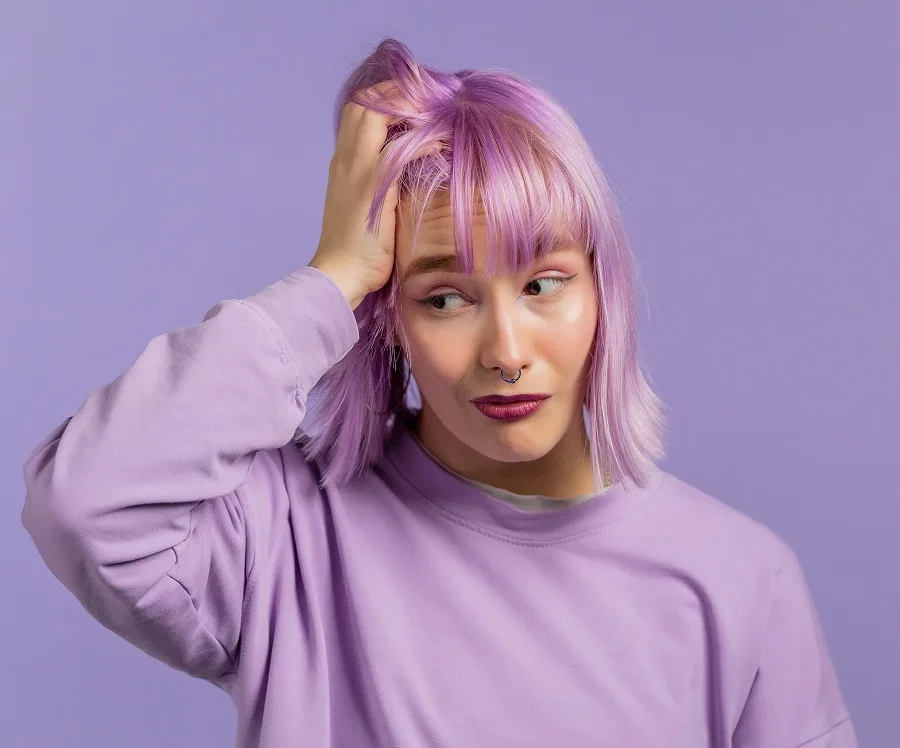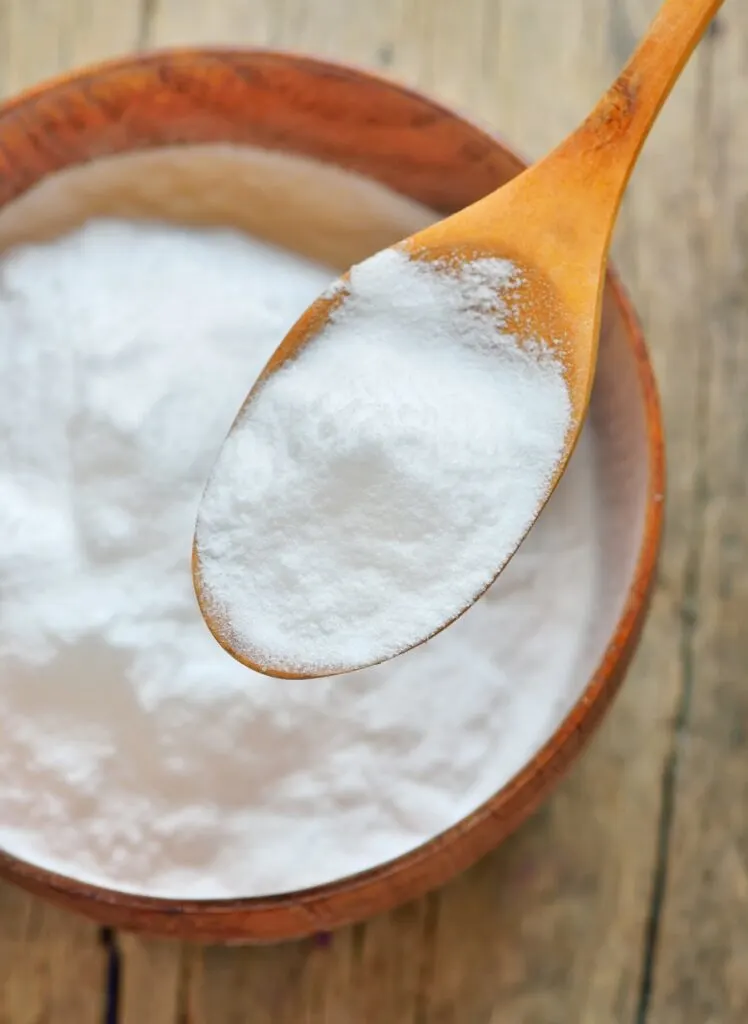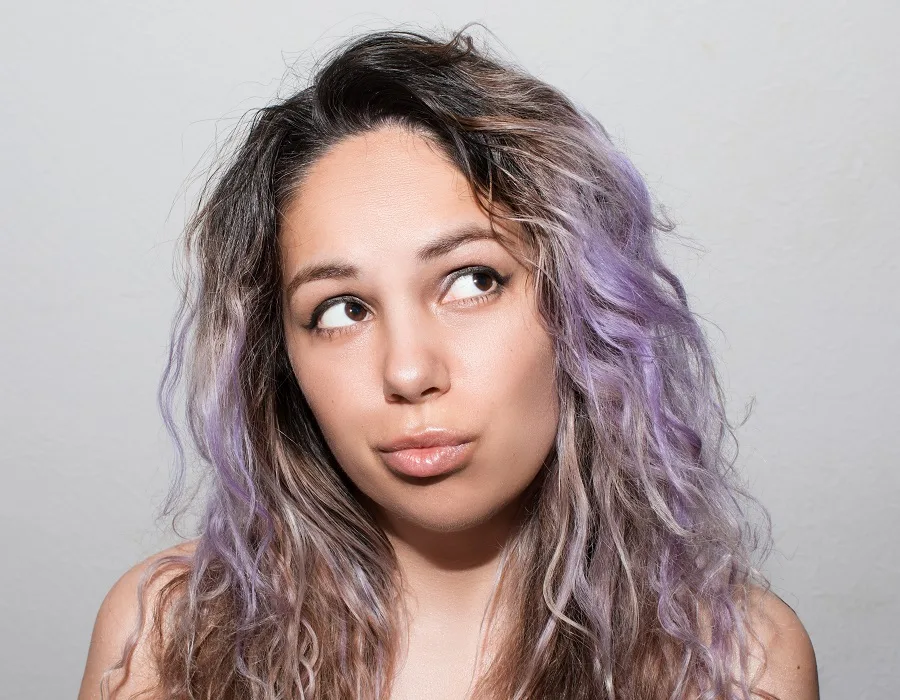Purple shampoo is a popular hair product for those maintaining their hair dye at home. It is easy to use and effective, but some people notice that purple shampoo turned hair purple.
If you jumped right into using this shampoo without reading the label, you could be in this situation.
Luckily, learning the reason behind the color change can help you fix the problem and avoid it in the future.
Why Did My Hair Turn Purple After Using Purple Shampoo?

Your hair can turn purple if the purple shampoo leaves too much blue pigment behind it after use.
This problem typically occurs after you make one of the four most common mistakes:
- You overused it.
- You applied it incorrectly.
- You used it on the wrong hair type.
- You chose the wrong purple shampoo.
Overuse
Purple shampoo reacts differently on various hair types. Unfortunately, this makes it challenging to know how much to use. Overuse results in darker, duller, and even purple hair.
Typically, purple shampoos are not replacements for daily shampoo. If you used it several times a week or daily, overuse was likely the cause of your purple hair.
Incorrect Application
If purple shampoo turned hair purple, you could have let the purple shampoo sit in your hair for too long. Providing it with too much time to set can result in staining before you even rinse it.
You should only leave most purple shampoos in your hair for two to five minutes. However, the product can still stain your hair if you only use it for two minutes. You must thoroughly rinse the shampoo out after each use.
You Have the Wrong Hair Type
Some purple shampoo brands use more pigments than others. While this works for many people, it can stain others’ hair types. Those with dry or damaged hair are more likely to encounter this dilemma.
Also, purple shampoo is ideal for those who dyed their hair a light color but not for those with darker hair.
You Have the Wrong Shampoo
There are three types of purple shampoo, and they are best suited for different situations.
- Highly-pigmented purple shampoo is designed for pre-toning and instant tonal deposit. It eliminates underlying warm tones.
- Silver toning for light bases is ideal for small silver shifts or eliminating brass. These shampoos are best for white or light hair.
- Shampoo that maintains and gently neutralizes can be used daily. It maintains blonde hair and eliminates yellow tones.
It is possible that purple shampoo turned hair to purple if it was not designed for your hair color,
Purple Shampoo Turned Your Hair Purple – Here’s The Fix
You can remove purple shampoo stains from hair with home remedies or hair products like:
Use Clarifying Shampoo
If purple shampoo turned your hair purple, use clarifying shampoo to reduce the number of purple pigments in your hair. Purple shampoo is not a dye, so clarifying shampoo should have no trouble eliminating the stain.
This unique shampoo removes any build-up on your hair, from hair products to chlorine in swimming pools.
Overall, you can use clarifying shampoo almost the same as a typical shampoo. However, you must shampoo your hair two to four times and rinse it extremely well. The first time, it may not lather, but it should the following times.
After the second shampoo application, let it sit for 20 minutes to break down residue from the purple shampoo. If your hair still feels dry, shampoo it a third or fourth time.
Color Remover
Most people do not need color remover after purple shampoo turned hair to purple, but it can help if you struggle to remove the purple pigments.
Unfortunately, color removers can damage hair and change the color of your hair due to the presence of bleach. Use it carefully and deep condition your hair when you finish.
Baking Soda

For a simple home remedy, mix 1-2 tablespoons of baking soda1 with shampoo. Then, apply it to your hair, and let it set for up to 30 minutes. Check the progress frequently and thoroughly rinse with warm water.
Lemon Juice
Place dish soap in your soaking wet hair and massage it from the roots to the ends. Rinse thoroughly, and add several drops of lemon juice to your hair. Massage it well, and leave it to soak for one minute. Finally, rinse thoroughly again.
Lemon juice works best when paired with Dawn dish soap rather than other dish soaps.
Does Purple Shampoo Leave Purple Stain?

Purple shampoo is a stain and can stain your hair or skin. It adds blue pigments to your hair, which can become apparent if you do not thoroughly rinse your hair or misuse the product. It can also cause product buildup, which can be difficult to remove.
Is Purple Shampoo Stains Permanent?
No, purple shampoo stains are not permanent. You can neutralize the purple hue by clarifying or toning shampoo and applying hair masks. You can also apply oil to the ends of your hair to restore the natural shine and reduce any damage caused by the purple shampoo.
Purple shampoo is not a dye, so it is easier to remove these purple stains from hair than it would be to remove purple hair dye.
Tips for Avoiding Purple Hair in the Future
The first step to avoiding purple hair is to read the label. You are far less likely to experience purple stains when you follow the manufacturer’s directions closely.
Continue to Use Your Normal Shampoo
Do not replace your typical shampoo with purple shampoo. Most days, you should continue to apply daily shampoo to cleanse your hair. Only use the purple shampoo once or twice a week.
Cut back on purple shampoo if you notice your hair changing color slightly.
Do Not Leave It in Your Hair for too Long
Most purple shampoos should remain in your hair for only two to three minutes. Allowing it to set for much longer gives the pigments time to settle into your hair.
Rinse Thoroughly
Always rinse all of the purple shampoo out of your hair. If you are not thorough, you may allow small amounts of shampoo to settle in your hair throughout the day.
Use the Right Shampoo
Follow these guidelines when selecting purple shampoo:
- Those with gray, silver, or platinum hair should use dark purple shampoo.
- Those with blonde hair should use bright purple or violet shampoo.
When you select the right shampoo, it is less likely that purple shampoo turned hair purple.
Avoid Purple Shampoo if Your Hair is Under Level 9
Purple shampoo was designed to tone blonde hair. It can benefit those with any hair color, but it is less predictable when you do not use it as intended.
Those with hair colors under level 9 are at a higher risk of purple hair. While it is not impossible to apply purple shampoo correctly if your hair is darker, it is more challenging.
Summary
Purple shampoo can restore the natural color of your hair and add shine. However, it can leave purple stains on the hair if not used correctly. To avoid this, it is important to use the correct amount of product, rinse it off thoroughly, and act quickly if you notice any discoloration.
- Purple shampoo can turn hair purple if it leaves too much blue pigment after use. This can happen if the shampoo is overused, applied incorrectly, used on the wrong hair type, or if the wrong purple shampoo is chosen.
- Overusing purple shampoo can result in darker, duller, and even purple hair as purple shampoos are not meant for daily use.
- Incorrect application such as letting the shampoo sit in the hair for too long can also lead to staining.
- Purple shampoos work differently on different hair types. Those with dry or damaged hair, or those with darker hair are more prone to staining.
- There are different types of purple shampoos designed for different hair situations. Using the wrong one for your hair color can turn it purple.
- Purple shampoo stains can be removed with clarifying shampoo, color remover, baking soda, or lemon juice.
- The stains from purple shampoo are not permanent and can be neutralized by using clarifying or toning shampoo and applying hair masks.
- Tips to avoid purple hair in the future include reading the label of the shampoo carefully, not replacing regular shampoo with purple shampoo, not leaving the shampoo in hair for too long, rinsing thoroughly, choosing the right purple shampoo for your hair type, and avoiding use if your hair color is under level 9.
You should also use protective gear, gloves, and deep-conditioning treatments to nourish and protect the hair.
Trending Topics
- How to Fix Red Hair That Has Turned Purple
- How Long to Wait Before Using Purple Shampoo After Bleaching?
- Blonde Hair Turned Green: How to Fix?
- Hair Turned Ginger After Dyeing Blonde
